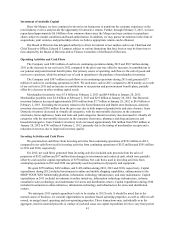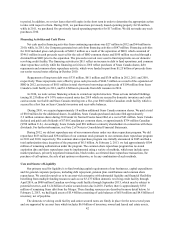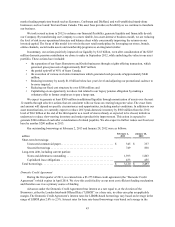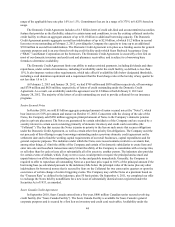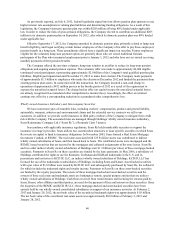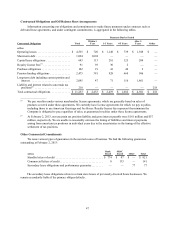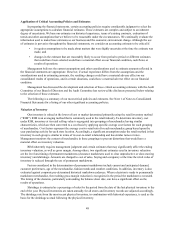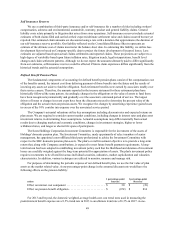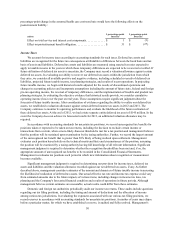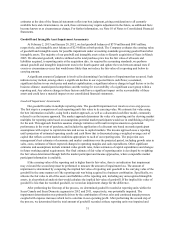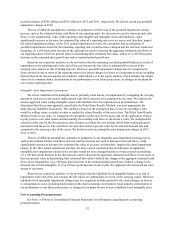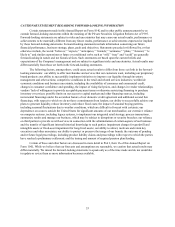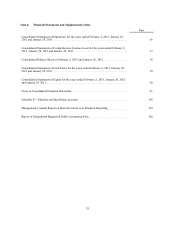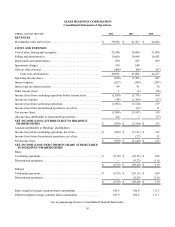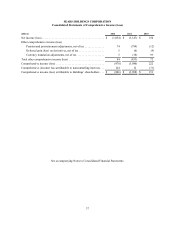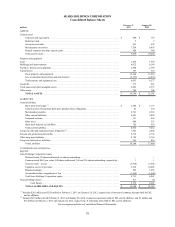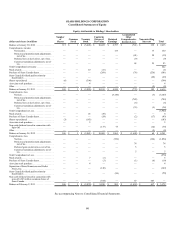Sears 2012 Annual Report Download - page 51
Download and view the complete annual report
Please find page 51 of the 2012 Sears annual report below. You can navigate through the pages in the report by either clicking on the pages listed below, or by using the keyword search tool below to find specific information within the annual report.51
estimates at the date of the financial statements reflect our best judgment, giving consideration to all currently
available facts and circumstances. As such, these estimates may require adjustment in the future, as additional facts
become known or as circumstances change. For further information, see Note 10 of Notes to Consolidated Financial
Statements.
Goodwill and Intangible Asset Impairment Assessments
At February 2, 2013 and January 28, 2012, we had goodwill balances of $379 million and $841 million,
respectively, and intangible asset balances of $2.9 billion at both periods. The Company evaluates the carrying value
of goodwill and intangible assets for possible impairment under accounting standards governing goodwill and other
intangible assets. The majority of our goodwill and intangible assets relate to Kmart's acquisition of Sears in March
2005. We allocated goodwill, which is defined as the total purchase price less the fair value of all assets and
liabilities acquired, to reporting units at the acquisition date. As required by accounting standards, we perform
annual goodwill and intangible impairment tests in the fourth quarter and update the tests between annual tests if
events or circumstances occur that would more likely than not reduce the fair value of a reporting unit below its
carrying amount.
A significant amount of judgment is involved in determining if an indicator of impairment has occurred. Such
indicators may include, among others: a significant decline in our expected future cash flows; a sustained,
significant decline in our stock price and market capitalization; a significant adverse change in legal factors or in the
business climate; unanticipated competition; and the testing for recoverability of a significant asset group within a
reporting unit. Any adverse change in these factors could have a significant impact on the recoverability of these
assets and could have a material impact on our consolidated financial statements.
Goodwill Impairment Assessments
Our goodwill resides in multiple reporting units. The goodwill impairment test involves a two-step process.
The first step is a comparison of each reporting unit's fair value to its carrying value. We estimate fair value using
the best information available, using both a market approach, as well as a discounted cash flow model, commonly
referred to as the income approach. The market approach determines the value of a reporting unit by deriving market
multiples for reporting units based on assumptions potential market participants would use in establishing a bid price
for the unit. This approach therefore assumes strategic initiatives will result in improvements in operational
performance in the event of purchase, and includes the application of a discount rate based on market participant
assumptions with respect to capital structure and access to capital markets. The income approach uses a reporting
unit's projection of estimated operating results and cash flows that is discounted using a weighted-average cost of
capital that reflects current market conditions appropriate to each of our reporting units. The projection uses
management's best estimates of economic and market conditions over the projected period, including growth rates in
sales, costs, estimates of future expected changes in operating margins and cash expenditures. Other significant
estimates and assumptions include terminal value growth rates, future estimates of capital expenditures and changes
in future working capital requirements. Our final estimate of fair value of reporting units is developed by weighting
the fair values determined through both the market participant and income approaches, where comparable market
participant information is available.
If the carrying value of the reporting unit is higher than its fair value, there is an indication that impairment
may exist and the second step must be performed to measure the amount of impairment loss. The amount of
impairment is determined by comparing the implied fair value of reporting unit goodwill to the carrying value of the
goodwill in the same manner as if the reporting unit was being acquired in a business combination. Specifically, we
allocate the fair value to all of the assets and liabilities of the reporting unit, including any unrecognized intangible
assets, in a hypothetical analysis that would calculate the implied fair value of goodwill. If the implied fair value of
goodwill is less than the recorded goodwill, we record an impairment charge for the difference.
After performing the first step of the process, we determined goodwill recorded at reporting units within the
Sears Canada and Sears Domestic segments in 2012 and 2011, respectively, was potentially impaired. The
impairment determination was primarily driven by the combination of lower sales and continued margin pressure
coupled with expense increases which led to a decline in our operating profit. After performing the second step of
the process, we determined that the total amount of goodwill recorded at these reporting units was impaired and


